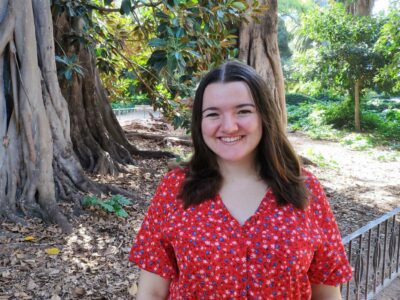
Protesters in the municipality of Rincón on the western coast of Puerto Rico have established a permanent presence at the construction site of a swimming pool that is being rebuilt after hurricane Maria destroyed it in 2017. Opponents of the construction say it is being built illegally. Screenshot from YouTube video uploaded by Carlos Mercado.
A coastal town like Rincón, located on the westernmost tip of the main island of Puerto Rico, is undeniably vulnerable to climate change and biodiversity loss.
That is why, over the course of several weeks, hundreds of people have protested at Los Almendros beach in Rincón, where a swimming pool destroyed by Hurricane Maria in 2017 is being rebuilt.
Residents are worried about accelerating environmental degradation, the government's historical lack of vision regarding climate change, suspicions of corruption because of the heavy police presence, and the hindered access to beaches due to private construction.
The pool belongs to a private beachfront apartment complex, Condominio Sol y Playa. Critics of the construction project claim that the pool is being rebuilt too close to the water, which was also the previous pool's flaw. With stronger and more frequent storms occurring in the Caribbean due to climate change, it stands to reason that the next hurricane that hits Puerto Rico could destroy the pool again.
In Puerto Rico, beaches are legally considered a public good and, therefore, must be accessible to people at all times. This has often been a point of contention between citizens and developers that build apartment complexes near the beach.
The following drone video shows where the pool was located:
Another point argued by critics is that the pool would be within Puerto Rico's maritime-terrestrial zone, swaths of land susceptible to be submerged by tides and larger waves during storms. Maritime-terrestrial zones are an important habitat for endangered species, such as leatherback and hawksbill sea turtles, which come to lay their eggs at Los Almendros beach. Recently, a hawksbill turtle was found within the construction perimeter and 180 eggs had to be removed and relocated. Currently, there are four hawksbill nests and two leatherback nests in the Los Almendros beach area.
Along Puerto Rico’s coastline, there is a multitude of examples of real estate projects that were somehow allowed to be built against Puerto Rico's environmental and building rules. The expected rising sea levels in the coming years will inevitably render some of those facilities uninhabitable, if not destroy them completely, putting human lives at risk. Scientists have long pointed out that this is not a question of if it will happen, but when. Atmospheric phenomena like Hurricane Maria, still an open wound for many Puerto Ricans, are a vivid reminder of Puerto Rico's vulnerability in the face of climate change.
The private pool project's environmental consultant, Ángel Román, insisted that it meets all requirements and is capable of withstanding another hurricane like Maria.
However, Puerto Rico's Department of Natural and Environmental Resources (Departamento de Recursos Naturales y Ambientales, or DRNA) previously issued a cease-and-desist administrative order in May. Its director, Rafael Machargo, then amended the order that same day, granting permission to continue construction.
The official narrative is that the initial administrative order was not clear and needed clarification, which is why a new order had to be issued. Director Machargo has refrained from commenting throughout the past few weeks. The irregular way in which the administrative order was handled and Director Machargo's silence have given rise to rumors of corruption.
The reconstruction of Condominio Sol y Playa's pool started to gain more attention when Eliezer Molina, a former political candidate for governor, denounced the project in a live video on his Facebook page in May. The video quickly went viral and was the catalyst for the protests and legal processes that are still ongoing.
In response, the government deployed a large number of police officers near the pool-to-be. Many users on social media have pointed out that such as large police unit is rarely deployed in circumstances where “they’re actually needed” to fight crime. As television personality Silverio Pérez put it:
La Policía de Puerto Rico sabe exactamente dónde están los puntos de drogas en el país pero nunca veremos un despliegue de policías vigilando la actividad delictiva que ocurre en esos puntos de drogas. Escogen enviarlos a Rincón, a proteger una propiedad privada de una protesta. pic.twitter.com/iEhaiqJe6l
— Silverio Pérez (@SilverioPR) July 26, 2021
The Puerto Rico Police know exactly where drugs are sold in the country, yet we never see a deployment of police in those areas. They choose to send them to Rincón to protect a private property from a protest.
Journalists have pointed out familial connections between the apartment owners and key political figures, including Governor Pedro Pierluisi himself, who has remained largely silent on the issue. Some have suggested that the unusually large police presence at a private construction site is related to these personal relationships.
An example of these connections is Governor Pierluisi’s cousin, Walter Pierluisi, who was a political director during the 2020 election campaign and owns an apartment in the building, as revealed by lawyer and journalist Jerohim Ortiz Menchaca:
Es importante recordar que el primo del gobernador, @pedropierluisi, Walter Pierluisi Isern, es dueño de apartamentos en el Condominio Sol y Playa en Rincón. Es decir, el gobernador está usando a la Policía de Puerto Rico para proteger un patrimonio familiar ilegal.
— Jerohim Ortiz Menchaca (@JerohimOM) July 22, 2021
It is important to remember that the cousin of the governor, @pedropierluisi, Walter Pierluisi Isern, owns apartments in Condominio Sol y Playa in Rincón. That is to say, the governor is using the Puerto Rico Police to protect an illegal family asset.
In recent days, several instances of police aggression towards protesters have been captured on video and shared widely on social media. The Puerto Rican chapter of the American Civil Liberties Union (ACLU) pointed out the police's failure to live up to its promises of reform on Twitter:
Once again we witness a PR police that clearly is barely reformed. Beating and arresting environmentalists protesting destruction of coastal beach and wildlife habitat to serve private interests is not free speech. Excessive force by PRPB is once again at the forefront. @aclu
— ACLU Puerto Rico (@ACLUPR) July 26, 2021
It remains to be seen how the construction at Rincón plays out, but Governor Pierluisi's Chief of Staff, Noelia García, clarified the government's stance in a recent radio interview with journalist Julio Rivera Saniel. García said that the government will validate the construction of the swimming pool if it met all legal requirements at the time when the permits were requested, regardless of how environmental conditions may have changed over time.







1 comment
This article is not entirely true that constructions has all the permissions given by law, the problem is that one of the people who live there didn’t want to pay their share to pay for the construction that’s all the problem causing this to start, then he called Eliezer Molina that was a failed candidate for the governor of Puerto Rico in the past election, and he got not even 2% of the votes, to get all these people to destroy private property and to intimidate all the people living in that condominium, they also have threatened the lives of the cops trying to protect the life and property for those people living in that condominium, there are other people who have their houses more closer to the beach than this condominium but they don’t protest for those constructions that are far worse than Sol y Playa condominium, this is a very high degree of hypocrisy and double standards by this protesters, and yes I live in Puerto Rico so I know what I’m talking about!